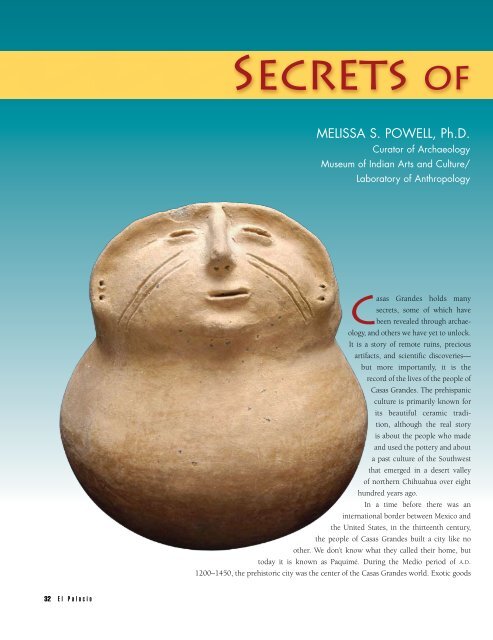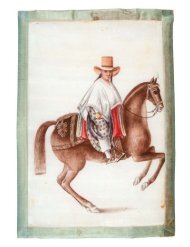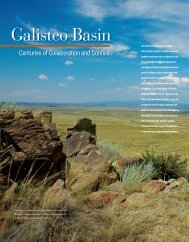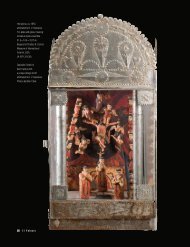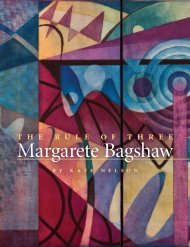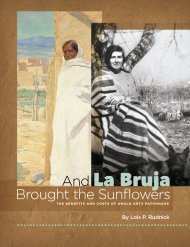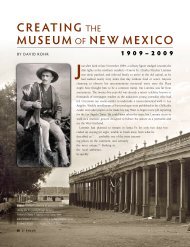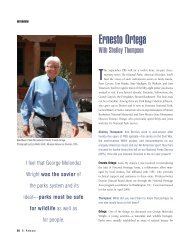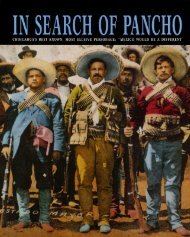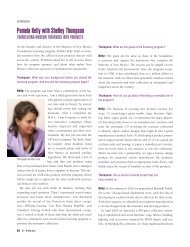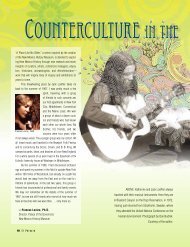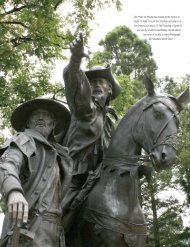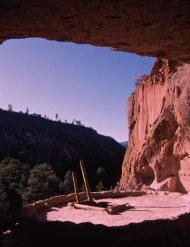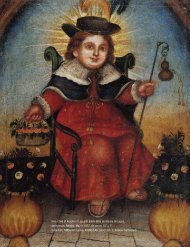Secrets of Casas Grandes - El Palacio Magazine
Secrets of Casas Grandes - El Palacio Magazine
Secrets of Casas Grandes - El Palacio Magazine
- No tags were found...
You also want an ePaper? Increase the reach of your titles
YUMPU automatically turns print PDFs into web optimized ePapers that Google loves.
<strong>Secrets</strong> <strong>of</strong>Melissa S. Powell, Ph.D.Curator <strong>of</strong> ArchaeologyMuseum <strong>of</strong> Indian Arts and Culture/Laboratory <strong>of</strong> Anthropology<strong>Casas</strong> <strong>Grandes</strong> holds manysecrets, some <strong>of</strong> which havebeen revealed through archaeology,and others we have yet to unlock.It is a story <strong>of</strong> remote ruins, preciousartifacts, and scientific discoveries—but more importantly, it is therecord <strong>of</strong> the lives <strong>of</strong> the people <strong>of</strong><strong>Casas</strong> <strong>Grandes</strong>. The prehispanicculture is primarily known forits beautiful ceramic tradition,although the real storyis about the people who madeand used the pottery and abouta past culture <strong>of</strong> the Southwestthat emerged in a desert valley<strong>of</strong> northern Chihuahua over eighthundred years ago.In a time before there was aninternational border between Mexico andthe United States, in the thirteenth century,the people <strong>of</strong> <strong>Casas</strong> <strong>Grandes</strong> built a city like noother. We don’t know what they called their home, buttoday it is known as Paquimé. During the Medio period <strong>of</strong> a.d.1200–1450, the prehistoric city was the center <strong>of</strong> the <strong>Casas</strong> <strong>Grandes</strong> world. Exotic goods32 <strong>El</strong> <strong>Palacio</strong>
<strong>Casas</strong> <strong>Grandes</strong>ABOVE: Several hundred T-shaped doorways were found at Paquimé. Photograph by Leif Percifield.LEFT: <strong>Casas</strong> <strong>Grandes</strong> plain ware effigy jar with closed eyes, <strong>Casas</strong> <strong>Grandes</strong>, a.d. 1200–1450. Museum <strong>of</strong> Indian Arts and Culture/Laboratory <strong>of</strong> Anthropology, 8335/11.<strong>El</strong> <strong>Palacio</strong> 33
secrets <strong>of</strong> casas grandesABOVE: Adobe architecture at Paquimé,the largest <strong>Casas</strong> <strong>Grandes</strong> site.RIGHT: Charles Di Peso examining a macaw pen at Paquimé.Macaws were symbolically important and prized for their feathers,which were traded to other areas <strong>of</strong> the Southwest. Courtesy <strong>of</strong> theAmerind Foundation, Inc., Dragoon, Arizona.at the site—copper, shell, turquoise, and macaws—tell us that<strong>Casas</strong> <strong>Grandes</strong> participated in a widespread trade and interactionnetwork that extended from northern Chihuahua intowhat is today the US Southwest.In many aspects Paquimé looks like a Southwesternpueblo, with multistory adobe roomblocks bordering plazasand pottery that is clearly part <strong>of</strong> the Southwesternpolychrome tradition. In other ways, <strong>Casas</strong> <strong>Grandes</strong> is anenigma. Ballcourts, monumental architecture, a stratifiedsocial hierarchy, macaw breeding, and ceramic effigies all suggestMesoamerican influences. <strong>Casas</strong> <strong>Grandes</strong> is not uniquelyPuebloan or Mesoamerican; it blends elements <strong>of</strong> both cultures.Located far north <strong>of</strong> classic Mesoamerica and south <strong>of</strong>the US Southwest, <strong>Casas</strong> <strong>Grandes</strong> has <strong>of</strong>ten been overlookedfrom both sides <strong>of</strong> the border, despite being one <strong>of</strong> the largestand most significant cultures <strong>of</strong> its time.Explorers and travelers to the Chihuahuan desert encounteredarid basins separated by the Sierra Madre OccidentalMountains and by three river valleys. Less than ten inches<strong>of</strong> rain fall each year, making rivers and springs essential forsustaining life. The first written accounts <strong>of</strong> the desert ruinswere made in 1584 by Spanish General Francisco de Ibarraand Baltasar de Obregón, who observed:There are many houses <strong>of</strong> great size, strength,and height. They are <strong>of</strong> six and seven stories,with towers and walls like fortresses forprotection and defense against the enemieswho undoubtedly used to make war on itsinhabitants. The houses contain large andmagnificent patios paved with enormous andbeautiful stones resembling jasper. There wereknife-shaped stones which supported the wonderfuland big pillars <strong>of</strong> heavy timber broughtfrom far away. The walls <strong>of</strong> the houses werewhitewashed and painted in many colors andshades. . .Charles Di Peso and the Amerind Foundation excavatedat <strong>Casas</strong> <strong>Grandes</strong> from 1958–1961. In bold style, Di Peso presentedthe vision that Paquimé was founded by Mesoamericantraders—pochteca—who established political control over34 <strong>El</strong> <strong>Palacio</strong>
secrets <strong>of</strong> casas grandesBELOW: Ramos Polychrome male smokereffigy jar, <strong>Casas</strong> <strong>Grandes</strong>, a.d. 1200–1450.Collection <strong>of</strong> Alan S. and Alice B. Fleischer.ABOVE: Ramos Polychrome olla with stylized macaws, <strong>Casas</strong> <strong>Grandes</strong>,a.d. 1200–1450. Collection <strong>of</strong> the Amerind Foundation, Inc., Dragoon, Arizona, 4605.<strong>Casas</strong> <strong>Grandes</strong>. He believed Paquimé was the outpost <strong>of</strong> aMesoamerican state where merchant rulers exploited localresources and controlled the exchange <strong>of</strong> shell, ceramics, copper,and turquoise, all channeled to classic Mesoamerica.Today there is little accepted evidence to support amodel <strong>of</strong> direct Mesoamerican intervention. However, DiPeso’s fascinating work still tells us much about the people<strong>of</strong> Paquimé. The great pueblo was the home <strong>of</strong> potters,stone workers, craft specialists, weavers, ball players,macaw breeders, hunters and farmers, traders, religiousleaders, and families. The city was densely populated withthree to five thousand people.Visitors to Paquimé immediately notice thick-walledadobe roomblocks, some with unusual cross and butterflyshapes. Paquimé contained about two thousand rooms.Setting it apart from other Southwestern sites, a ceremonialprecinct includes ballcourts, a colonnaded gallery, anelite tomb complex, and seven massive platform mounds.Archaeologists Michael Whalen and Paul Minnis characterizethe imposing, substantial nature <strong>of</strong> the buildings as architecture<strong>of</strong> power, designed to awe visitors to Paquimé eighthundred years ago, much as it does today.The control <strong>of</strong> water was an integral feature, with a sophisticatedwater system linking domestic reservoirs to a spring.There was an underground well, and stone-lined canals suppliedwater and drained refuse. In surrounding areas, irrigationditches directed water for the farming <strong>of</strong> corn, beans, andsquash, a diet supplemented by the hunting <strong>of</strong> game.<strong>Casas</strong> <strong>Grandes</strong> is the only area <strong>of</strong> the Southwest withevidence <strong>of</strong> macaw breeding. Nesting pens with heavy entrystone rings protected caretakers from the sharp beaks andclaws <strong>of</strong> the birds. Several hundred macaw skeletons, alongwith eggshells, are evidence <strong>of</strong> breeding. Scarlet macaws(Ara macao) are not native to <strong>Casas</strong> <strong>Grandes</strong>. Their naturalhabitat is tropical lowland areas such as Veracruz. Macawswere raised for trade in feathers, or less commonly for export<strong>of</strong> the birds themselves. Macaws were prized for their brilliantfeathers, used in ceremonies. Most macaws found incontemporaneous archaeological contexts in the Southwestprobably came from <strong>Casas</strong> <strong>Grandes</strong>. Macaws appear on <strong>Casas</strong><strong>Grandes</strong> pottery in realistic and stylized designs, emphasizingtheir great cultural significance.<strong>El</strong> <strong>Palacio</strong> 35
secrets <strong>of</strong> casas grandesTHIS PAGE: Ramos Polychrome bird effigy jar,possibly a duck or killdeer, <strong>Casas</strong> <strong>Grandes</strong>,a.d. 1200–1450. Museum <strong>of</strong> Indian Arts and Culture/Laboratory <strong>of</strong> Anthropology, courtesy <strong>of</strong> Johnand Linda Comstock and the Abigail VanVleck Charitable Trust, 8365/11.OPPOSITE PAGE: HuerigosPolychrome Janus-faced jar, <strong>Casas</strong><strong>Grandes</strong>, a.d. 1200–1450. Collection <strong>of</strong>Alan S. and Alice B. Fleischer.<strong>Casas</strong> <strong>Grandes</strong> ballcourts were places for gatherings <strong>of</strong>great importance. Southwestern kivas are absent, and ballcourtslinked together neighboring communities. Paquimé hastwo I-shaped ballcourts <strong>of</strong> Mesoamerican style with a playingfield enclosed by raised sides. I-shaped ballcourts occur atfifteen smaller Medio-period sites in northern Chihuahua,most within a day’s walk <strong>of</strong> Paquimé. Visiting teams fromother areas <strong>of</strong> <strong>Casas</strong> <strong>Grandes</strong> may have traveled this distanceto participate in games.The ballgame was probably an exciting part <strong>of</strong> communitylife played for diversion and to mark ritual occasions.The events were likely accompanied by feasting at nearbyagave roasting pits. We do not know exactly how the <strong>Casas</strong><strong>Grandes</strong> ballgame was played. It may have been similar toan Aztec version where players hit a rubber ball with thehips, while other depictions show the ball returned withsticks or the hands and feet. Mesoamerican ballcourtsoccur in areas with factionalized, competing leaders, leadingsome archaeologists to propose that <strong>Casas</strong> <strong>Grandes</strong>ballcourts signify ongoing competition and rivalry betweenneighboring elites.OriginsOne <strong>of</strong> the secrets <strong>of</strong> <strong>Casas</strong> <strong>Grandes</strong> is where the people originated.Some look to distant sources, such as Stephen Lekson’sassertion that Chaco Canyon elites traveled south along aChaco Meridian to found <strong>Casas</strong> <strong>Grandes</strong>. A stronger casecan perhaps be made for development from local beginningsin northern Mexico. Cerros de trincheras—fortified hilltopterraces—were residential and agricultural sites from 1000b.c.–a.d. 500, a surprisingly early date. The terraced settlementsreveal a significant late Archaic population in the areaand demonstrate the importance <strong>of</strong> sedentism, defense, andthe appearance <strong>of</strong> agriculture.Origins <strong>of</strong> <strong>Casas</strong> <strong>Grandes</strong> are seen in pithouses and plainpottery that appear around a.d. 200, traits shared with theMogollon culture <strong>of</strong> the Southwest. People lived in farmingvillages <strong>of</strong> clustered pithouses and made textured and red-onbrownpottery during the early Viejo period (a.d. 600–1075).By a.d. 1075–1200, their descendents lived in surface houseswith plazas. A dramatic change occurred when Paquimé wasbuilt in the Medio period (a.d. 1200–1450), a time <strong>of</strong> greaterpopulation aggregation and a pr<strong>of</strong>usion <strong>of</strong> eight different polychromeceramic types.36 <strong>El</strong> <strong>Palacio</strong>
secrets <strong>of</strong> casas grandesThe Ceramic TraditionThe people <strong>of</strong> <strong>Casas</strong> <strong>Grandes</strong> left no written accounts but theirpottery has endured to tell us about their society. Potters collectedhigh-quality local white clays to form vessels by hand.The typical form is a globular jar or olla. Ceramics were usedeveryday in both domestic and ritual contexts.The striking pottery <strong>of</strong> the Medio period (a.d. 1200–1450)has bold geometric designs painted in red and black on a lightbackground. <strong>Casas</strong> <strong>Grandes</strong> potters produced a wide variety<strong>of</strong> types and forms. Ramos Polychrome is the most prevalent,and appears to have been made in the core area and exportedto other villages. Archaeologist Maria Sprehn finds that therise <strong>of</strong> pottery specialization coincided with the rise <strong>of</strong> an elitein the Medio period, as elite patrons may have commissionedspecialist artists to make the finest pieces.The symbolic importance <strong>of</strong> macaws and serpents isunmistakable, as they are among the images most frequentlydepicted on pottery. Serpents may symbolize Quetzalcóatl,Mesoamerican deity <strong>of</strong> the underworld, or they may be connectedto the Water Serpent <strong>of</strong> the Pueblos. Although the birdserpent may have been transmitted from Mesoamerica, it islikely that the underlying ideas may have been interpreted differentlyas this symbol spread throughout the Southwest.One <strong>of</strong> the secrets <strong>of</strong> <strong>Casas</strong> <strong>Grandes</strong> that continues topuzzle archaeologists is why potters madesuch a variety <strong>of</strong> ceramic effigyjars. Effigies are sculptural formsdepicting animals, humans, andother beings. They portraybirds, badgers, fish, andturtles, along with fantasticalcomposite creaturessuch as a cross betweena rabbit and a bird.“Janus” pots have thesame face on both sides,reflecting the importance<strong>of</strong> duality. Hooded effigies,with a human-like head abovea jar, have been interpreted by DiPeso as Mesoamerican deities. Oneresearcher argues that effigy vessels were setin wall niches in domestic rooms, where they may havebeen used to present food and drink <strong>of</strong>ferings.Female and male effigies may be more closely related toa Mesoamerican tradition, as human effigies are rare in theSouthwest. Information about dress and adornment are seenin details <strong>of</strong> jewelry, textiles, sashes, headbands, and facialdecoration. Females are seated with both legs extended, whilemales kneel or have one knee flexed to the chest. ArchaeologistChristine VanPool argues that smoking male effigies depictritual activity and may represent shamans, possible religiousleaders <strong>of</strong> <strong>Casas</strong> <strong>Grandes</strong>.Exotic Goods and <strong>El</strong>itesExotic artifacts at Paquimé surpass amounts found at otherSouthwestern sites. Workshop and storage rooms containedornaments <strong>of</strong> shell, copper, and turquoise. Over four millionpieces <strong>of</strong> shell were found, weighing one and a half tons. Shellwas transported from the coast and made into jewelry. Fivethousand pieces <strong>of</strong> turquoise were found, as jewelry and buriedin room corners as <strong>of</strong>ferings. Turquoise likely originatedfrom the Cerrillos mines or Burro Mountains <strong>of</strong> New Mexico.A probable trade network exported the sacred stone from theSouthwest to central Mexico.<strong>Casas</strong> <strong>Grandes</strong> society appears to have centered arounda prestige goods economy based on long-distance trade <strong>of</strong>macaws, shell, and turquoise. One <strong>of</strong> its secrets is why exoticgoods were stockpiled at the site. Somepropose Paquimé was a pilgrimage centeror that the goods represent storedwealth. Exotic goods may havebeen controlled by elites whowere religious leaders. Theassociation <strong>of</strong> elites withrare artifacts and symbols<strong>of</strong> authority reveals statusdifferences among the<strong>Casas</strong> <strong>Grandes</strong> people.The RegionalSystemWe are only beginning tounderstand the role <strong>of</strong> Paquiméwithin the larger region. The surroundingarea contains hundreds <strong>of</strong> sites, just nowbeing scientifically studied, that were all part <strong>of</strong> the <strong>Casas</strong>continued on page 88<strong>El</strong> <strong>Palacio</strong> 37
secrets <strong>of</strong> casas grandescontinued from page 37<strong>Grandes</strong> system. Nearby villages also have polychrome ceramics,T-shaped doors, macaw pens, and ballcourts. Some outlyingsites share similarities with the core area, but do not appearto have been under direct political control <strong>of</strong> Paquimé.The wider <strong>Casas</strong> <strong>Grandes</strong> interaction sphere includedpeople who lived in what is today southern New Mexico andArizona. The Joyce Well site in Hidalgo County, New Mexico,has <strong>Casas</strong> <strong>Grandes</strong> ceramics, T-shaped doors, and ballcourts,indicating ties to Paquimé. Similarities in ceramics also demonstrateinteraction with Jornada Mogollon people to thenortheast and with the Tonto Basin <strong>of</strong> central Arizona.The End <strong>of</strong> the<strong>Casas</strong> <strong>Grandes</strong> WorldBy a.d. 1450, Paquimé and the surrounding area were abandoned.Di Peso argued that the city was destroyed by burning during anattack from outside enemies. He described macaws left in pens,unfinished crafts in storerooms, pit ovens filled with agaves, andbroken altar stones. Some archaeologists think that the close <strong>of</strong>the <strong>Casas</strong> <strong>Grandes</strong> era was less dramatic, and influenced by forcessuch as changing environmental conditions.The remaining people <strong>of</strong> <strong>Casas</strong> <strong>Grandes</strong> migrated to theSonoran river valleys, according to Di Peso. They may have<strong>Casas</strong> <strong>Grandes</strong> at the Maxwell MuseumBy David A. Phillips, Jr., Ph.D.,Curator <strong>of</strong> Archaeology, Maxwell MuseumPhoto courtesy Maxwell MuseumOnce you’ve seen the Museum <strong>of</strong> Indian Arts and Culture<strong>Casas</strong> <strong>Grandes</strong> exhibit, be sure to visit BeyondBorders at the Maxwell Museum at the University<strong>of</strong> New Mexico in Albuquerque. Beyond Bordersbegan life as a traveling exhibit on internationalcooperative studies in the <strong>Casas</strong> <strong>Grandes</strong>region. (For more information on those studies,see Tim Maxwell’s August 2006 article in<strong>El</strong> <strong>Palacio</strong>.) The December reincarnation <strong>of</strong> theexhibit will include artifacts from the Maxwell’scollections.No <strong>Casas</strong> <strong>Grandes</strong> exhibit would be complete withoutexamples <strong>of</strong> the pottery, for which the culture is best known (andwhich, sadly, has encouraged so much looting in <strong>Casas</strong> <strong>Grandes</strong>sites). The Albuquerque exhibit includes several pieces to helpillustrate current theories about the pottery’s symbolic content.One <strong>of</strong> the authors <strong>of</strong> those theories, Christine VanPool, developedher ideas while a graduate student at UNM, so it’s especiallyappropriate to mention them in the expanded exhibit. Dr. VanPoolstudied the Maxwell’s pottery but also examined hundreds <strong>of</strong>vessels from other collections, including those at theMuseum <strong>of</strong> Indian Arts and Culture.The Museum <strong>of</strong> New Mexico and the MaxwellMuseum have common roots, through—whoelse—Edgar Lee Hewett. Besides foundingthe museum system and School <strong>of</strong> AmericanResearch in Santa Fe, Hewett established thedepartment <strong>of</strong> anthropology at the University<strong>of</strong> New Mexico (and a few other programsbesides). The Maxwell Museum began as acouple <strong>of</strong> display cases <strong>of</strong> the department’s holdings,in a university hallway, back in 1932; today it’s anindependent unit <strong>of</strong> UNM. Next year we’ll celebrate our 75thanniversary.The Beyond Borders exhibit opening will be from 11:00 to2:00 on Saturday, December 2, 2006, and will continue until earlyMay 2007. We invite our <strong>El</strong> <strong>Palacio</strong> friends to drop by that day,or in the following months, to get a second look at the <strong>Casas</strong><strong>Grandes</strong> culture. Admission to the Maxwell Museum is free. Formore information, please call 505-277-4405. n88 <strong>El</strong> <strong>Palacio</strong>
Ramos Polychrome female effigy vessel, possibly depicting a birth scene,<strong>Casas</strong> <strong>Grandes</strong>, a.d. 1200–1450. Collection <strong>of</strong> Alan S. and Alan B. Fleischer.joined new statelets that also participated in extensive tradenetworks. Others may have resettled in ancestral Pueblocommunities that were part <strong>of</strong> the <strong>Casas</strong> <strong>Grandes</strong> interactionsphere. When the Spanish arrived at the end <strong>of</strong> the sixteenthcentury, Suma Indians were living in the area, and the vibrantregional center <strong>of</strong> Paquimé was only an abandoned ruin.Regional surveys and Mexican-US collaborations areunderway, research that will bring to light more answers to theremaining secrets <strong>of</strong> <strong>Casas</strong> <strong>Grandes</strong>. With these projects comesgrowing awareness that <strong>Casas</strong> <strong>Grandes</strong> is a significant part <strong>of</strong>the Native American heritage <strong>of</strong> the Southwest, bringing thisimportant culture the recognition it deserves.The pottery <strong>of</strong> <strong>Casas</strong> <strong>Grandes</strong> lives on today in a differentform. The village <strong>of</strong> Mata Ortiz, located sixteen miles fromPaquimé, is a community <strong>of</strong> 400 potters known for its contemporaryart. Although not direct descendents <strong>of</strong> the <strong>Casas</strong><strong>Grandes</strong> people, Mata Ortiz potters have revived the designsand forms <strong>of</strong> the prehistoric pottery over the past thirty years,finding acclaim on the international art market. Today MataOrtiz ceramics have moved far beyond direct imitation <strong>of</strong> theprehistoric vessels. The new styles reflect the constantly evolvingdiversity and creativity <strong>of</strong> Mata Ortiz potters—an artistic traditionthey share with the ancient potters <strong>of</strong> <strong>Casas</strong> <strong>Grandes</strong>. n


